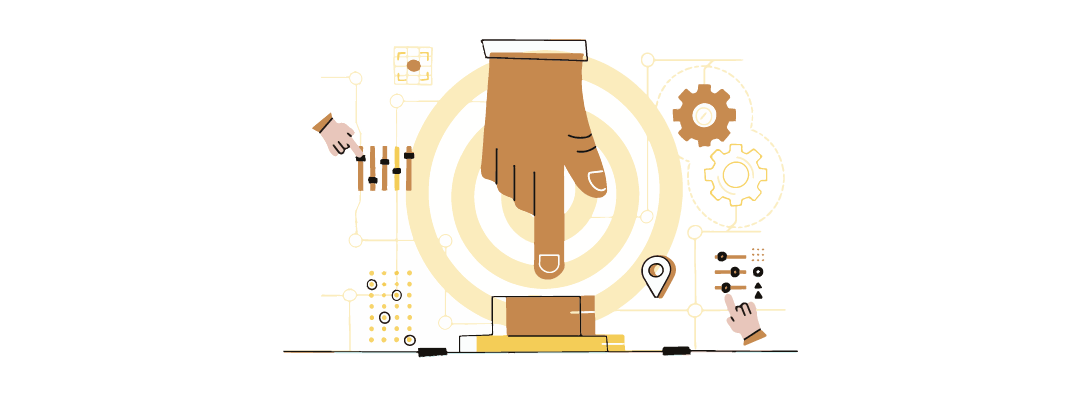
Customer Experience
The Crossroads of Digital Identity, Personalization and Privacy
Digital identity is the foundation of personalization for end users and better outcomes for businesses, but changes to customer engagement, driven by an increased demand for privacy, are reshaping the industry.
The digital privacy landscape has changed. Upgraded from hardware cable locks to GDPR in the European Union and CCPA in California, the definition of digital asset protection has shifted from physical goods to personal identifiable information (PII).
Digital brands have been left to navigate a gray space found between providing industry-leading engagement opportunities and the looming threat of overstepping the limits of personal identity protections. This space is the crossroads of customer experience, where digital identity, personalization and privacy are all forced to intersect.
Best practices for delivering customer experience in the age of digital privacy
Digital identity is the foundation of personalization that provides a better experience for end users and better outcomes for businesses, but changes to customer engagement driven by an increased demand for privacy are reshaping the industry. These new forces are rushing digital-first businesses to adapt quickly, or be left behind.
Amid a rush to develop customer engagement and protect personal information, the digital marketplace has provided a new question. Can individual users actually own their digital identities, and how can brands help those users receive the most from their digital presence.
The Paradoxon

When browsing the web, using mobile apps, or on connected devices customers have come to expect a personalized experience that shows them content and ads that match their interests. This introduces them to new entertainment and products that meet their needs that they may not have found on their own. However, many don’t realize the level of tracking and analytics needed to drive this and a fear of data sharing is causing a significant number of users to opt-out of sharing data and tracking.
Changes to the Data Privacy Landscape
Businesses have been presented with a landscape of data privacy pitfalls and consumer concern.
Trends in the technology industry, led by the major players such as Apple, Google, and Microsoft, along with new regulatory hurdles placed by governments all over the world have had significant effects on how businesses can collect and use consumer data.
1. Computer Cookies
Magic Cookies, also known as HTTP Cookies or Computer Cookies, have been used since the mid-nighties to help websites determine what content to display to which digital users.
Cookies are small text files embedded in a user’s browser when they visit a website. These text files serve as digital beacons. They allow companies to track user behavior on site or around the web in order to build profiles for targeting and segmentation. Each new interaction can create a touchpoint worthy or cookie tracking.
Common uses of cookies are seen everyday as websites maintain shopping cart information across sessions on the same device. These are known as 1st party cookies. Data privacy fears have been stoked as consumers realize that cookies can also be used outside of the issuing domain by employing 3rd party cookies.
Apple Safari, Mozilla Firefox, and Microsoft Edge already block 3rd party cookies, and Google Chrome recently announced that they will phase out cookies over the next couple of years resulting in over 90% of the market removing cookies. This will limit marketers’ ability to track users outside of their own domain and significantly reduce their ability to gather data on customer behavior.
2. GDPR and CCPA
GDPR, the privacy regulations that apply to users in the European Union, and CCPA, privacy regulations that apply to California residents, have imposed new restrictions that affect nearly all companies that collect and process user data in some way.
Customers have increasingly more control over their data, including the ability to prevent companies from collecting it and deleting data that has already been collected, forcing marketers to be more transparent with what data is collected, how it is used, and who it is shared with. Meanwhile, U.S. states including Virginia, Florida, New Hampshire, Washington, Nebraska, New York, Maryland, and North Dakota are considering passing similar legislation.
The advent of greater customer control over collection and use of customer data presents businesses with a new question: what do customers need to feel comfortable with offering their data.
3. Apple App Tracking Transparency
With its latest updated, Apple has made data protection more accessible for customers across its digital channels.
As part of Apple’s 14.5 release, they implemented new App Tracking Transparency terms which limit an app’s ability to track a user and join their data with 3rd party data providers. Apple’s Identifier for Advertisers (IDFA) is similar to a cookie in that it allows marketers to track the effectiveness of campaigns in iOS apps. Apple has already allowed users to opt out of IDFA tracking, leading to over 30% of users disabling tracking. Apple will now require all users to opt in, which some firms estimate will lead to an 85 – 90% reduction in the number of users who consent to personal data collection.
UPDATE: Evolving Privacy Rules for Apple & Google
Recent announcements from Apple and Google highlight the ever changing privacy landscape.
During Apple’s WWDC 2021, Apple announced that with the launch of iOS15 (~Fall 2021) there will be new privacy measures to enable email privacy protection, generate privacy reports, enable users to hide their emails, and more.
In a separate update, Google shared that they will introduce new tracking requirements which would allow users to opt out of passing Ad IDs (late 2021) and also requiring apps to submit an Android Nutrition label which discloses how they use data (Q2 2022).
Bottom Line
Many of the popular tools and methods for identifying customers across the open web are being phased out by platform providers and regulators.
These new rules of the road will change the business model and strategies for companies that rely on these personalization methods. These companies now face a new sort of digital transformation.
Adapting to a New Privacy Landscape

The keys to success in digital advertising are precision, meaning targeting to serve the most relevant ads, and scale, meaning an ability to reach the widest audience. Google, Facebook, and Amazon have been able to create “walled gardens” where they control all of the user data they use which has allowed them to excel at both of these, allowing them to capture the lion’s share of advertising revenue at nearly 70% of digital ad dollars. In order to maintain profitable business models publishers and advertisers must innovate to find new ways to build their own 360° view of their customers where they can get to know their users and personalize experiences.
First Party Data Collection
Companies will need to ramp up efforts to collect data on customers within their own ecosystems to replace the data previously collected around the open web in order to develop their own 1:1 relationship with users. Ultimately this data will become more valuable and actionable as it will be the most relevant to their business.
Here are tactics companies can explore to collect first-party data from their customers.
- Increase Transparency: Marketers can see data as means to empower new customers. However before leveraging data to build stronger customer relationships, they need to earn customer trust.
Explain the benefits of sharing data to encourage users to opt in. After a bitter and public fight against Apple’s new IDFA changes, Facebook has designed its own screen that will inform users that its ad tracking will be used to offer more relevant ads, and support small businesses who advertise on the platform. The timing of this prompt should be related to a value proposition that will entice the user to opt in, and should explain how this tracking is not new, but rather a continuation of how the internet has worked since inception and a critical component of what makes many free services possible.
- Loyalty Programs: Loyalty programs can help customers feel strong ties to the brands they frequent. Adding automation to create frictionless digital experiences can build even stronger customer loyalty.
For transactional services like e-commerce, where you have an exchange of value with a customer and want to encourage repeat interactions through personalized messaging, loyalty programs can be a great way to incentivize customers to sign up for an account and share personal data in exchange for rewards.
By spurring more sign ups, loyalty programs can help convert anonymous users into known users who can be added to a database and served personalized offers.
- Progressive Profiling: Businesses can use customer decision making to their advantage to create more detailed cohorts and customer journeys.
Build out a customer’s profile over time by asking relevant questions related to their actions rather than presenting them with an overwhelming survey when they first sign up.
For example, if they are looking for local content or products then present them with a prompt asking for their zip code, or if they’re searching for a birthday gift then ask them what their birthday is.
- User Behavior Tracking: Once a user authenticates or starts interacting with your service it is critical to capture data on their behavior, such as watching a piece of content, favoriting a show, or viewing a product. This activity gives contextual clues about what a user is interested in and can be used in conjunction with progressive profiling to build more robust data sets that can be used to personalize future interactions with a particular customer and also to build audience segments.
3rd Party Data
Although 3rd Party data tracking is becoming harder, there are still ways to access information found beyond the reach of a singular business.
To supplement 1st party data collected directly, companies can work with 3rd party data providers to fill in the gaps and paint a fuller picture of their customers. There are a variety of methods to consider based on a company’s capabilities and needs.
Universal Identifiers
A number of new identifiers to replace cookies are being created, such as the Unified ID 2.0, which is a new open source standard developed by The Trade Desk and managed by industry trade groups IAB and Prebid. The ID is based on an anonymized user email address gathered when a user logs into a website or app and can be used to identify users who interact with its member companies, which include a wide range of ad tech companies and publishers. The Unified ID 2.0 is applicable across the whole digital ecosystem beyond desktop – mobile, CTV, etc – and provides more transparency to the user on what it is and how it will be used. By participating in the Unified ID ecosystem marketers can share anonymized data about their users with others to create a more robust understanding of users instead of buying data from 3rd parties.
External Data Sources
The Unified ID might not be the right fit for everyone, and another way to supplement data collected through first party sources is to purchase data on existing and potential customers from third party data brokers like Experian that provide additional details about your customers based on data matching. With the disappearance of cookies it will be much more difficult for individual companies to build a robust profile of user activity across the web on their own, and third party data sets can help fill in the gaps.
360 Degree Customer View

In order to make sense of your 1st and 3rd party data you’ll need a data management platform to aggregate and consolidate both anonymized and PII data into audiences and segments you can use to personalize your customer engagement. This will allow for personalization at the individual level for authenticated users where data is available and at the audience level for unauthenticated users and who have opted out of data collection.
Personalization

Personalization can significantly improve performance of digital products, boosting revenue by 5 – 15% and increasing marketing spend efficiency by 10 – 30%. Once data has been collected and analyzed it can be used to better serve customers with compelling experiences.
Audience
Users can be grouped into higher level audience segments for broader personalization efforts. This allows for targeting unauthenticated users and A/B testing in higher volume to determine the effectiveness of campaigns.
The future of personalization will require companies to be more creative, sophisticated, and transparent than ever before due to changing regulations and consumer expectations. Increasing transparency, incentivizing users to share data, and partnering with other players in the ecosystem will enable publishers, advertisers, and brands to continue to offer personalized experiences that are critical to business success in the digital age.
Individual
At the individual level registering identity data is a pivotal step in creating long term relationships with customers.
Users who can be identified through authentication (checkouts and subscriptions) can be communicated with on a 1:1 level. This direct communication maximizes the effectiveness of marketing engagement efforts. identity data may also provide for better omnichannel experiences by de-anonymizing cohort data. With this greater level of information, product experiences can be tailored to an individual based on their preferences. Tailored experiences can be seen in a streaming platform highlighting adventure shows to a travel buff, or in surfacing the latest dating show to a reality TV fan. Everything from content to copy should be targeted towards a user persona at the most granular level and A/B tested for optimization.
The future of personalization will require companies to be more creative, sophisticated, and transparent than ever before due to changing regulations and consumer expectations. Increasing transparency, incentivizing users to share data, and partnering with other players in the ecosystem will enable publishers, advertisers, and brands to continue to offer personalized experiences that are critical to business success in the digital age.


